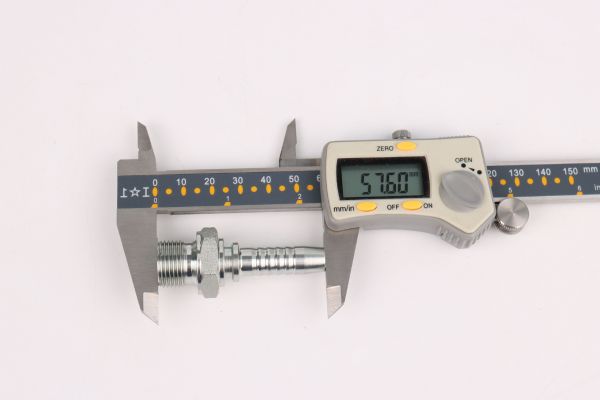BSP hydraulic fittings are essential components used in a variety of applications, from industrial machinery to agricultural equipment. These fittings, standardized to ensure compatibility and reliability, come in two main types: BSPP (British Standard Pipe Parallel) and BSPT (British Standard Pipe Tapered). This guide aims to provide a detailed reference to BSP hydraulic fitting dimensions, offering comprehensive tables, measurement techniques, and best practices to help professionals accurately identify, measure, and utilize BSP fittings in their projects.
BSP (British Standard Pipe) hydraulic fittings are a widely adopted standard in the hydraulic and plumbing industries, ensuring consistent and reliable connections across various systems and applications. These fittings are characterized by their unique thread design and are crucial for creating secure and leak-proof connections in hydraulic systems. There are two primary types of BSP hydraulic fittings:

BSP hydraulic fittings are utilized across a broad spectrum of industries due to their versatility and reliability. Some of the key sectors that rely on BSP fittings include:
BSP (British Standard Pipe) fittings are defined by precise dimensions and specifications to ensure compatibility and functionality across various applications. Understanding these dimensions is crucial for selecting the right fitting and ensuring proper installation and performance.
General Dimensions for BSP Fittings
Thread Type | Full Name | Sealing Method | Thread Form | Thread Angle | Key Standard | Application |
BSPP | British Standard Pipe Parallel | O-ring or bonded washer (flat face seal) | Parallel | 55° | ISO 228 | Hydraulic, pneumatic systems |
BSPT | British Standard Pipe Tapered | Metal-to-metal thread engagement | Tapered (1:16) | 55° | ISO 7 / BS 21 | Thread sealing in pipe systems |
ISO 1179 | BSPP-based hydraulic port thread | O-ring face seal inside port | Parallel | 55° | ISO 1179 | High-pressure hydraulic ports |
Understanding the differences between BSP (British Standard Pipe), NPT (National Pipe Tapered), and JIC (Joint Industry Council) threads is crucial for selecting the appropriate fitting for a given application. Each thread standard has unique characteristics that influence its suitability for various hydraulic and plumbing systems.

Feature | BSPP | BSPT | NPT | JIC |
Thread Type | Parallel | Tapered | Tapered | Parallel |
Thread Angle | 55° | 55° | 60° | 37° flare |
Sealing Method | O-ring / washer | Metal-to-metal | Thread sealant | Flare metal seal |
Standard | ISO 228 | ISO 7 / BS 21 | ANSI B1.20.1 | SAE J514 |
Accurate measurement and identification of BSP (British Standard Pipe) fittings are essential for ensuring proper fit and function in hydraulic systems. This section provides an overview of the tools and instruments required for measuring BSP fittings, along with a step-by-step guide to identifying thread types and dimensions.
Identifying Thread Type (Parallel or Tapered):
Measuring Thread Diameter and Pitch:
Determining Nominal Size:

Sealing Methods:
Understanding the compatibility and interchangeability of BSP fittings with other hydraulic fittings and systems is crucial for maintaining system performance and preventing leaks. By considering the thread types, sealing methods, pressure ratings, and material limitations, you can ensure seamless integration and reliable operation of your hydraulic systems. Proper use of adapters and conversion fittings further enhances the flexibility and compatibility of BSP fittings in diverse applications.
Proper installation of BSP (British Standard Pipe) fittings is critical for ensuring reliable, leak-free connections in hydraulic systems. This section covers the essential techniques, sealing methods, torque specifications, common installation errors, and maintenance tips for BSP fittings.
In this guide, we covered the essential aspects of BSP hydraulic fittings, including their types, dimensions, measurement techniques, compatibility with other fittings, installation best practices, and maintenance tips. Accurate dimensioning is crucial for ensuring optimal performance and preventing leaks in hydraulic systems. For specific needs and precise measurements, it is highly recommended to consult detailed dimension tables and reliable resources. Proper understanding and application of these principles will lead to efficient and reliable hydraulic connections.
The two main types of BSP hydraulic fittings are BSPP (British Standard Pipe Parallel) and BSPT (British Standard Pipe Tapered).
You can identify if a BSP fitting is parallel (BSPP) or tapered (BSPT) by measuring the thread diameter at multiple points. If the diameter is consistent, it’s BSPP; if it decreases, it’s BSPT.
BSPT fittings typically use PTFE tape or thread sealant for sealing, while BSPP fittings often use an O-ring or bonded seal to prevent leaks.
BSP fittings are not directly compatible with NPT or JIC fittings due to differences in thread angles and profiles. Special adapters are required to connect these fittings properly.
To measure BSP fittings, you will need thread gauges, calipers, and micrometers to determine the thread type, diameter, and pitch accurately.
Ensure proper installation of BSP fittings by cleaning the threads, using the correct sealing method, following torque specifications, and avoiding common errors like over-tightening or cross-threading.